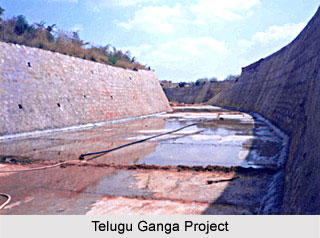 The Telugu Ganga project is a water supply scheme employed in South India. This project started with the mission to provide drinking water to Chennai city in Tamil Nadu. This project is also known as the Krishna Water Supply Project, owing to the source of the water to be the Krishna river in Andhra Pradesh.
The Telugu Ganga project is a water supply scheme employed in South India. This project started with the mission to provide drinking water to Chennai city in Tamil Nadu. This project is also known as the Krishna Water Supply Project, owing to the source of the water to be the Krishna river in Andhra Pradesh.
Water for the Telugu Ganga project is drawn from the Srisailam reservoir and sidetracked towards Chennai through a series of inter-linked canals, covering a distance of about 406 km. Finally; the water of this reservoir reaches the destination at the Poondi reservoir near Chennai. The main checkpoints in this route include the Somasila reservoir in Pennar valley, the Kandaleru reservoir, the `Zero Point` near Uthukkottai and finally, the Poondi reservoir, also known as Satyamurthy Sagar. The water enters Tamil Nadu territory at the `Zero Point` near Uthukkottai. Water is distributed through a system of link-canals to other storage reservoirs situated at Red Hills, Sholavaram and Chembarambakkam from Poondi.
The Telugu Ganga project was sanctioned in 1977 after an accord that was reached between Tamil Nadu and the states across which the Krishna River flows, namely Andhra Pradesh, Maharashtra and Karnataka. According to the agreement, each of these three states should be contributing 5 thousand million cubic ft (TMC) of water annually, for a total supply of 15 TMC. This number was lowered down to 12 TMC in 1983. After a cycle of delays, the project was completed in 2004, during this very year Poondi reservoir received Krishna water for the first time. According to a survey, the Telugu Ganga project supplied 3.7 TMC water to Chennai city in 2006.















